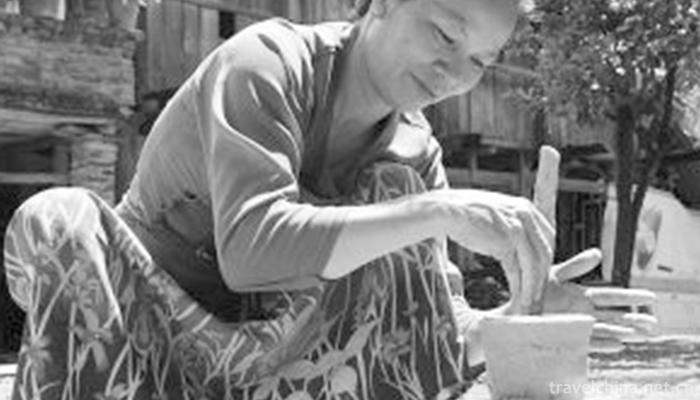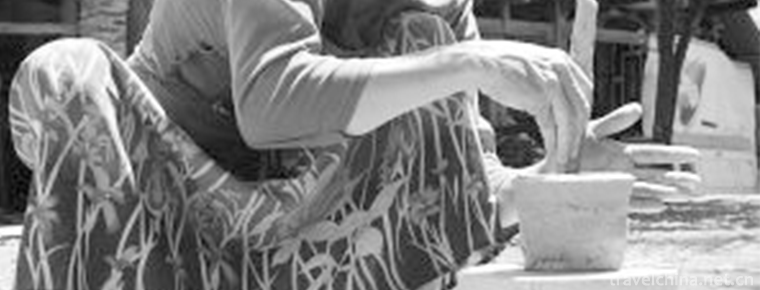Dais Slow Wheel Pottery Technology
Dais Slow Wheel Pottery Technology
Dai Slow-wheel pottery, the primitive traditional handicraft of Yunnan, is one of the national intangible cultural heritages.
Dai people like to use pottery since ancient times. Pottery making is called "plate mill" in Dai language, commonly known as "earthen pot". The biography of Baiyi, written by Qian Zuxun in the early Ming Dynasty, said that the Dai people "only use the utensils for moulding". Unlike other nationalities, Dai ceramics are handed down from generation to generation by women.
On May 20, 2006, the Dai slow-rotation pottery technology was approved by the State Council to be listed in the first batch of national intangible cultural heritage, numbered -5.
historical origin
In the Ninth Section of "Making Porcelain and Pottery" of Chapter 10 of the Dai Genesis Epic "Batama Ga Pan Shangluo", God said to Sang Mudi, "People eat every day, people drink water every day, and there are no bowls and pots. What do you use to fill them? The leaves are too soft and the bark is too crisp to hold the soup. Make bowls out of soil. There is black soil beside the water, and loess, loess and black soil beside the water. They are the dirt of the earth. Where can people get them? Use them to knead `Wan'(Dai: bowl) and use them to knead `Mo' (Dai: pot). Use it to pinch "oz" (Dai: earthen basin)." After God's instructions, mulberry bottoms let people take clay to knead earth bowls, pots and pots. They are round, square and tubular in shape, but these newly made pottery products can not be used because they are "eaten by water, run with water, and carry heavy". Therefore, God again pointed out to the people: "Now the earth makes bowls, but also after drying, and then burning it with fire, so that the soil hardens, so that the bowl hardens, water does not eat, and people can use it easily. This is called"Gongwan"(Dai: bowl burning), which is called"Gongmo"(Dai: pot burning). From then on, people learned to knead bowls, people learned to cook pots, generation after generation. From the vivid description of Dai ancestors'pottery making in the epic, we can see that they began to make pottery in order to meet the actual needs of daily life in the Payasanmudi era, and mastered the pottery making technology in constant practice. Therefore, the Dai people have a very long history of pottery making, which can be traced back to at least 4000 years ago. The biography of Baiyi in the Ming Dynasty also recorded that "folk vessels, bottles, pots and the like, only Taozhi."
In the past, the inheritance of traditional pottery craft was mainly based on the family inheritance of mother-in-law or daughter-in-law. From preparation for soil selection, excavation, making pottery, firing pottery till final sale, women completed the inheritance. There is no man in the whole pottery field, and men are not allowed to see it when they burn the kiln. It is said that as long as men see it, the pottery will be cracked, leading to the abandonment of previous achievements. Therefore, we can see from these phenomena that the Dai ancestors naturally divided their labor according to gender. Today, Dai women are still carrying on this ancient tradition, shouldering the responsibility of handmade pottery technology and passing this skill on to the next generation of women, but this division of labor has no strict boundaries, and men are beginning to participate in it.
Process characteristics
The most prominent feature of Dai's pottery making technique is the slow wheel handcraftsmanship. The surface of the pottery is patted with grained wooden pats, which is consistent with the printed pottery unearthed from the Neolithic sites in South China.
Dai pottery is also fastidious in its material use, mainly by adding sand and gravel to improve its moulding performance. Its roasting method also has its own characteristics, including open-air roasting and closed semi-roasting and other methods. The method of billet forming is diversified, such as whether or not the runner is made, toe-pulling slow wheel, hand-pulling runner and so on. These ancient pottery-making techniques are still used by the Dai people.
Technological process
Dai ceramics mainly have runners, wooden rackets, bamboo scrapers, stone balls and so on. The main technological processes include scouring soil, sieving soil, mixing sand, seepage, installation of turntables, billet making, blanking, drying, preparation of pottery, pottery firing and other links.
Dai Slow-wheel pottery is a traditional handicraft of Dai people. Slow wheel is an important pottery tool invented by Neolithic primitive humans after they learned to knead pottery blanks by hand. Its base is made of wood, and then it is covered with a wheel made of stone. With the development of the times, because the fast wheel is easier to form, the slow wheel pottery is gradually replaced by the fast wheel pottery. In Xishuangbanna Dai Autonomous Prefecture, Jinghongmandou, Menghamanluan Station, Menghai Manza Village and Menglong Village still retain relatively complete Slow-wheel pottery skills.
Inheritance and protection
Inheritance value
In addition to meeting the needs of daily life and spiritual life, Dai Slow-wheel pottery has rich social and cultural values, which are reflected not only in the ancient handicraft production methods and technological processes, but also in the production and life of the Dai people. It profoundly reflects the traditional lifestyle of the Dai people and its changes, and has been passed on from generation to generation, becoming a carrier of cultural memory, thus building the Dai people's cultural memory. The unique cultural representation system of ethnic groups.
Inheritance status
With the deepening of the modernization process, traditional Dai pottery is not easy to see in other occasions, except for a small number of decorations and Buddhist rituals for the roof of buildings. In addition, the economic benefits of pottery making are not ideal, so fewer and fewer people study and engage in pottery making. In Xishuangbanna, only a few families in a few villages still make pottery. The original pottery art is in a state of imminent extinction and needs urgent rescue and protection.
Inheriting characters
Yumeng, Female, Dai, Dai Autonomous Prefecture, Xishuangbanna, Yunnan Province, Dai inheritor of slow-rotation ceramics. December 28, 2017, was selected as the fifth batch of national intangible cultural heritage representative project representative successors recommended list. In May 2018, it formally became the representative successor of the fifth batch of National Intangible Cultural Heritage Representative projects. Item: Dai Slow-wheel pottery technology.
protective measures
Since the late 1950s, archaeologists at home and abroad have made many special investigations on Dai pottery making. They believe that traditional Dai pottery making is the representative of Chinese primitive pottery art and the key to solving the mystery of Chinese Neolithic pottery firing.
In 2009, Zhang Haichao's Mandou Dai Slow Wheel Ceramics presented a panoramic picture of the intangible cultural heritage of Dai Slow Wheel Ceramics. In order to enhance readers'understanding of intangible cultural heritage and promote the extensive and effective development of protection practice.
social influence
Important activities
In September 2018, the Dai Garden Scenic Area in Xishuangbanna launched non-material cultural heritage projects such as Dai Zhangha, Dai slow-rotation ceramics and Dai brocade skills for tourists. The purpose of the exhibition is to publicize and popularize intangible cultural heritage and to raise the social attention of the protection of intangible cultural heritage projects.


-
1.Kanas Scenic Area in Altay Area
Kanas Scenic Area is located in the middle section of Altai Mountain in Xinjiang, which is located in the border area between China and Kazakhstan, Russia and Mongolia
Time 2018-12-12 -
2.Lianzhou Underground River Scenic Spot
Lianzhou City is located in the northwest of Guangdong Province and the upper reaches of Lianjiang River. The northeast is connected with Yizhang County in Hunan Province
Time 2018-12-12 -
3.Tianhetan Scenic Area
Tianhetan is located in Shibanzhen, Huaxi District, Guiyang City, Guizhou Province. It is a scenic spot with typical karst natural scenery as the main part and historical celebrities
Time 2019-02-21 -
4.The story of Xie Jin
Xie Jin (Dec. 6, 1369 - Feb. 22, 1415), a literary Minister of Ming Dynasty, was born in Jishui, Ji'an Prefecture, Jiangxi Province.
Time 2019-05-06 -
5.Flower hopping shed
Dancing Huapeng, introduced from Fujian in Ming Dynasty, is an ancient traditional folk dance, belonging to Nuo dance. It has a fixed "Keben" (singing desk book), which is divided into 18 br
Time 2019-06-21 -
6.Tujia Year
Tujia Year is an important and ancient festival of Tujia people in Xiangxi Tujia and Miao Autonomous Prefecture of Hunan Province. During the thousands of years of historical development, some relativ
Time 2019-06-23 -
7.Xiangyuan Drum Book
Xiangyuan Drum Book is a traditional opera in Shanxi Province. Originated in Xiangyuan, Shanxi Province, it is popular in Shangdang area. It is also called Guer Ci and Xiangyuan Tune. According to leg
Time 2019-07-06 -
8.Construction Techniques of Yanmen Folk House
Yanmen folk house construction technology is a traditional skill with local characteristics in Xinzhou, Shanxi Province. It was listed in the third batch of intangible cultural heritage list in 2011.
Time 2019-07-10 -
9.Yao Folk Songs
Yao folk song is a popular Yao folk song in Ruyuan Yao Autonomous County of Shaoguan City. Yao language is called "Saihua handle". It is translated into Chinese to mean "the language th
Time 2019-07-11 -
10.Zhou Cuns Baking Cake Making Skills
Zhou Cun's baking technology has a history of more than 1,800 years. According to Zizhi Tongjian, in the three years since Emperor Heng of Han Dynasty Yanxi, Hucai vendors have been exiled in Shandong
Time 2019-08-10 -
11.Bian Que
Bian Que (407 BC - 310 years ago) Ji surname, Qin Shi, name slowly, the word Yue people, also number Lu medicine, the spring and Autumn period and the Warring States period famous doctor. The spring a
Time 2019-09-06 -
12.Wuliangye distillery
Wuliangye Group Co., Ltd. is located at the intersection of Jinsha River and Minjiang River, the first city of the Yangtze River -- "Jiudu" Yibin. It is a modern corporate group with Wuliangye series liquor production as its main business
Time 2020-10-16